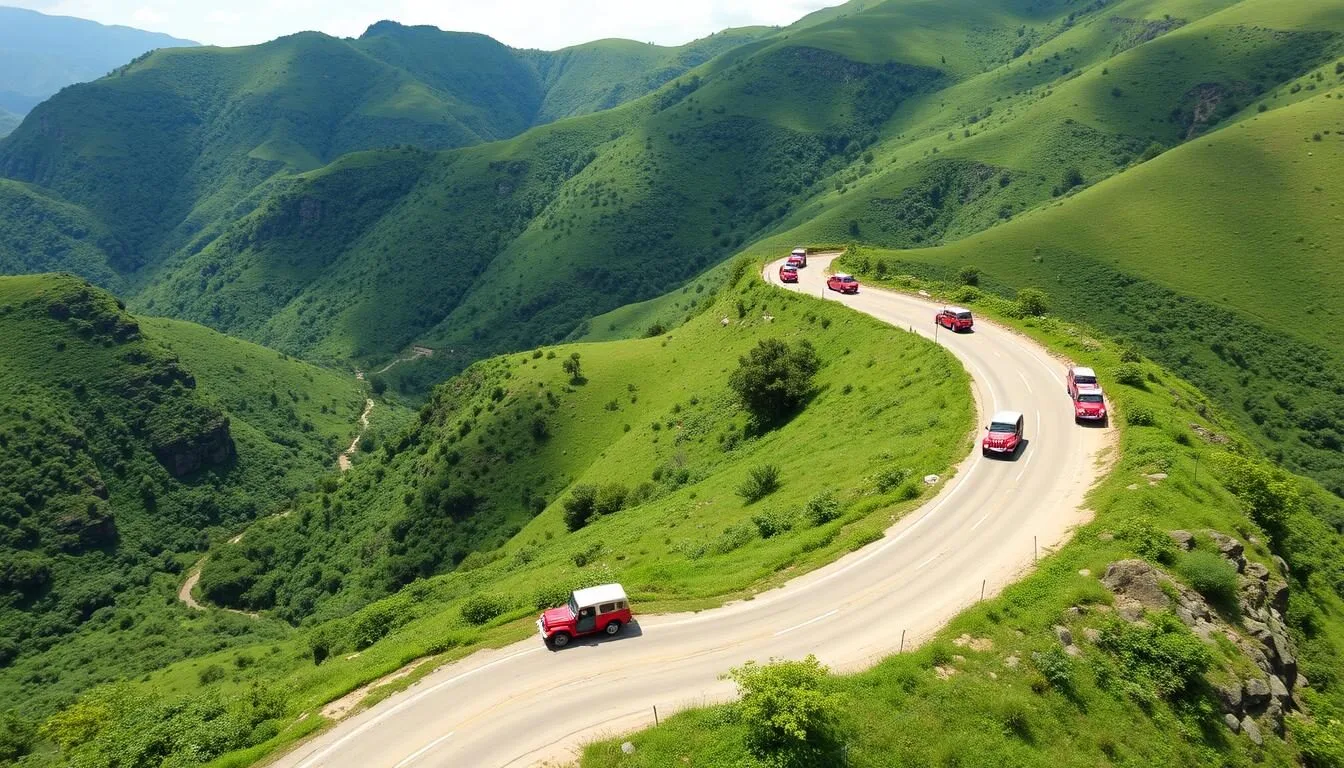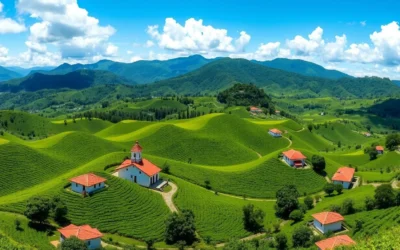Home to the world’s tallest palm trees, with some reaching an astonishing 60 meters (197 feet) in height, the Cocora Valley (Valle de Cocora) creates one of Colombia’s most surreal and breathtaking landscapes. This verdant paradise, nestled in the heart of Colombia’s coffee region, offers travelers a chance to walk among giants in a setting that feels plucked from a fantasy novel. As the iconic symbol of Colombia’s Quindío department and a vital part of Los Nevados National Natural Park, the valley’s towering wax palms create a scene unlike anywhere else on Earth.
Getting to Cocora Valley & Planning Your Journey
The Cocora Valley is located near the charming town of Salento in Colombia’s coffee region (Eje Cafetero). Most travelers use Salento as their base for exploring the valley, as it offers the most convenient access point.
From Major Colombian Cities
If you’re coming from elsewhere in Colombia, you’ll first need to reach either Armenia or Pereira, the two gateway cities to the coffee region:
- From Bogotá: Direct flights to Armenia (1 hour) or Pereira (1 hour) are available daily. Alternatively, buses take approximately 8-9 hours.
- From Medellín: Flights to Armenia or Pereira take about 30 minutes. Buses take approximately 6-7 hours through scenic mountain roads.
- From Cali: Buses to Armenia take about 3-4 hours.
From Armenia or Pereira to Salento
Once you’ve reached either Armenia or Pereira, you have several options to get to Salento:
- By Bus: Regular buses run from both cities to Salento, taking approximately 45 minutes from Armenia and 1 hour from Pereira. Tickets cost around 8,000-10,000 COP ($2-3 USD).
- By Taxi: A more comfortable but pricier option, with fares around 80,000-100,000 COP ($20-25 USD) from either city.
- By Rental Car: If you prefer flexibility, renting a car allows you to explore the region at your own pace. The roads are generally in good condition but can be winding through mountain terrain.
Ready to start your Cocora Valley adventure?
Book your transportation to Colombia’s coffee region and start your journey to this natural wonder.
From Salento to Cocora Valley
The final leg of your journey from Salento to the Cocora Valley is an experience in itself:
- By Willy Jeep: These colorful, traditional jeeps depart from Salento’s main square (Plaza de Bolívar) starting at 6:30 AM, with the last return jeep leaving Cocora around 6:00 PM. The one-way journey costs approximately 5,000 COP ($1.25 USD) and takes about 30 minutes.
- By Private Transport: You can hire a private jeep or taxi for around 40,000-50,000 COP ($10-13 USD) one way.
- Organized Tour: Many travelers opt for guided tours that include transportation, a guide, and sometimes meals.
Pro Tip: For the best experience, arrive at the main square early (before 8:00 AM) to catch a Willy jeep to Cocora Valley. This helps you avoid both crowds and afternoon rain, which is common in the region. Standing in the back of an open Willy offers spectacular views during the journey!
Best Time to Visit Cocora Valley

The Cocora Valley, like much of Colombia’s coffee region, experiences a relatively consistent climate year-round due to its proximity to the equator. However, rainfall patterns and tourist crowds vary significantly throughout the year.
Weather Patterns
Located at an elevation of approximately 2,400 meters (7,874 feet), the valley enjoys a cool mountain climate with average temperatures ranging from 12°C to 25°C (54°F to 77°F). Mornings are typically clear and sunny, while afternoons often bring clouds and occasional rain.
| Season | Months | Weather | Crowd Level | Recommendation |
| Dry Season (Primary) | December to February | Mostly sunny, occasional afternoon showers | High (peak season) | Excellent for hiking, book accommodations in advance |
| Rainy Season (Primary) | April to May | Frequent rain, trails can be muddy | Low | Bring rain gear, trails may be slippery |
| Dry Season (Secondary) | June to August | Mild, less rainfall | Moderate | Good balance of weather and fewer crowds |
| Rainy Season (Secondary) | September to November | Increased rainfall, occasional heavy storms | Low | Less ideal for hiking, but lush landscapes |
Recommended Months to Visit
The best time to visit Cocora Valley is during the dry seasons from December to February and June to August. These periods offer the most favorable conditions for hiking and outdoor activities with clearer skies and less mud on the trails.
Best Time to Visit
- December to February: Clearest skies and best trail conditions
- June to August: Good weather with moderate crowds
- Early mornings (6-10 AM): Best visibility before clouds roll in
Times to Avoid
- April to May: Heaviest rainfall, muddy trails
- Colombian holidays: Extreme crowds, especially Easter week
- Afternoons (after 2 PM): Higher chance of rain and fog
Weather Tip: Regardless of when you visit, always be prepared for sudden weather changes. Pack layers, a rain jacket, and waterproof hiking boots. Morning fog often clears by 9-10 AM, revealing spectacular views of the valley and palm trees.
Getting Around Cocora Valley

Once you arrive at the Cocora Valley entrance, you’ll find several options for exploring this magnificent landscape. The valley is primarily explored on foot, though horseback riding is also popular.
Hiking Trails
The valley offers several hiking options, with the main trail being a loop that takes you through diverse ecosystems:
- Full Loop Trail: This 12 km (7.5 mile) circuit takes approximately 5-6 hours to complete. It passes through cloud forests, crosses several rivers via suspension bridges, visits the Acaime hummingbird sanctuary, and concludes with the iconic wax palm forest.
- Direct Palm Trail: If you’re short on time, you can take a direct 2 km (1.2 mile) path to the wax palm forest, which takes about 30-45 minutes each way.
- Extended Hikes: More adventurous travelers can continue beyond the standard loop to explore deeper into Los Nevados National Park (requires additional permits and preferably a guide).
Trail Tip: Most guides recommend hiking the loop counter-clockwise, saving the spectacular palm forest for the end of your journey. This also means tackling the steepest sections early in the day when you have more energy.
Horseback Riding
For those who prefer not to hike or want a different experience, horseback riding is a popular alternative:
- Horses can be rented at the valley entrance for approximately 40,000-60,000 COP ($10-15 USD) for a 2-3 hour guided ride.
- Routes typically include the palm forest and some sections of the valley that are less accessible on foot.
- No prior riding experience is necessary, as the horses are well-trained and guides accompany all riders.
Experience Cocora Valley with expert guides
Book a guided tour to make the most of your visit with local knowledge and hassle-free transportation.
Trail Fees and Logistics
There are a few practical details to be aware of when exploring the valley:
- Entrance Fees: The main trail has two checkpoints with separate fees. The first costs approximately 5,000 COP ($1.25 USD), and the second (if taking the full loop) costs about 6,000 COP ($1.50 USD).
- Acaime Sanctuary: Visiting the hummingbird sanctuary costs an additional 6,000 COP ($1.50 USD), which includes a complimentary hot chocolate and cheese (a traditional Colombian combination).
- Facilities: There are basic restaurants and restrooms at the valley entrance and at the Acaime sanctuary, but limited facilities on the trails themselves.
Where to Stay Near Cocora Valley

While there are no accommodations within the Cocora Valley itself, nearby Salento offers a range of lodging options from budget hostels to luxury boutique hotels. Alternatively, some travelers choose to stay in glamping sites or coffee farms (fincas) in the surrounding countryside for a more immersive experience.
Staying in Salento
Most visitors base themselves in Salento, a charming colonial town just 30 minutes from the valley:
Budget Options
Salento offers numerous hostels with dorm beds starting around 30,000-40,000 COP ($8-10 USD) per night. Many include breakfast and offer private rooms as well.
Recommended: Viajero Hostel Salento, Casa La Eliana
Mid-Range Hotels
Boutique hotels and guesthouses range from 150,000-300,000 COP ($40-80 USD) per night, often featuring traditional architecture and garden settings.
Recommended: Hotel Salento Real, Terrazas de Salento
Luxury Accommodations
For a premium experience, luxury lodges and haciendas in the area offer upscale amenities and exceptional service from 400,000 COP ($100 USD) and up.
Recommended: Hacienda Bambusa, Hotel Kawa Mountain Retreat
Unique Accommodation Experiences
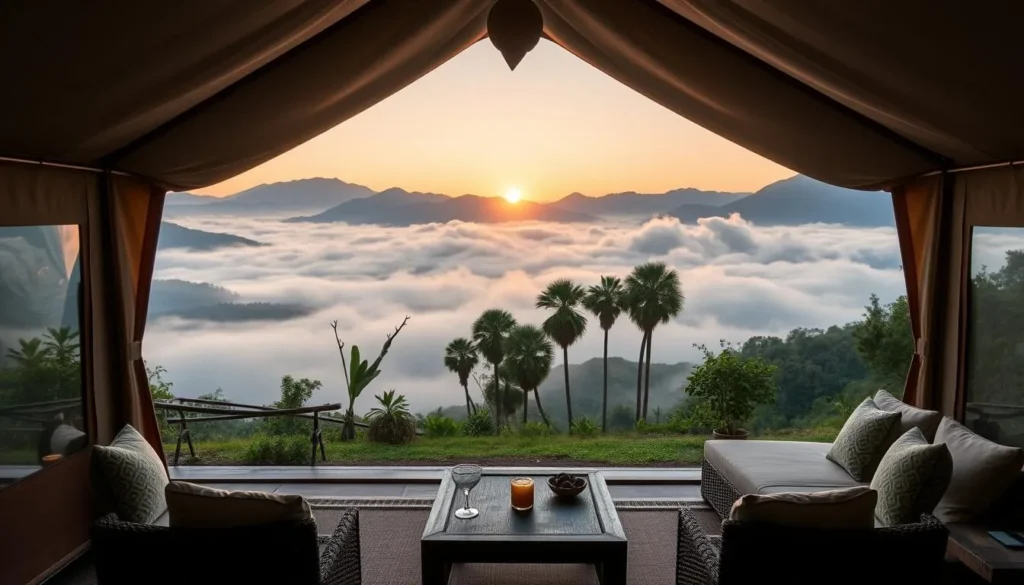
Coffee Farm Stays
Experience life on a working coffee farm by staying at one of the many fincas in the region. These range from rustic to luxurious and often include coffee tours and farm-to-table meals.
Recommended: Finca El Ocaso, Finca Don Eduardo
Glamping
For nature lovers, glamping sites offer the perfect balance of comfort and immersion in the stunning landscapes surrounding the valley.
Recommended: Lumbre Glamping, Glamping Momoto Cocora
Find your perfect stay near Cocora Valley
Book your accommodation in advance, especially during high season (December-February) when availability becomes limited.
Accommodation Tip: If you’re planning to hike the Cocora Valley early in the morning (recommended to avoid crowds and afternoon rain), consider staying in Salento rather than more distant cities like Armenia or Pereira. This will allow you to catch the first Willy jeeps to the valley around 6:30 AM.
Dining & Local Cuisine

The Cocora Valley region offers delicious Colombian cuisine with some specialties unique to the coffee region. Most dining options are found in Salento, though there are a few restaurants at the valley entrance.
Regional Specialties
- Trucha (Trout): The signature dish of the region, typically served with patacones (fried plantains), rice, and avocado. Local rivers are rich with trout, making this an ultra-fresh option.
- Bandeja Paisa: A hearty traditional Colombian plate featuring beans, rice, ground beef, chicharrón (fried pork belly), fried egg, avocado, and arepa (corn cake).
- Patacones: Flattened and twice-fried green plantains, often served as a side dish or with toppings as an appetizer.
- Arepas: Corn cakes that can be filled with cheese, meat, or eaten plain as a side dish.
Where to Eat
In Cocora Valley
There are a few rustic restaurants at the valley entrance serving traditional Colombian dishes:
- Donde Juan B: Known for excellent trout dishes with valley views
- Restaurante Valle del Cocora: Traditional Colombian cuisine in a scenic setting
These restaurants are perfect for lunch after completing your hike, but they can get crowded during peak hours.
In Salento
The town offers a wider range of dining options:
- El Rincón de Lucy: Authentic Colombian food at reasonable prices
- Donde Laurita: Famous for its trout in various preparations
- Cumana Bistro Food: Venezuelan and Colombian fusion
- Café Bernabé Gourmet: Upscale dining with beautiful views
- Brunch de Salento: International options and packed lunches for hikers
Coffee Culture

Being in Colombia’s coffee region, sampling the local coffee is a must-do experience:
- Jesús Martín: Award-winning coffee shop in Salento offering premium beans and various brewing methods.
- Café Concreto: Modern coffee shop with excellent espresso-based drinks.
- La Casa Café Galería: Charming café with a vintage atmosphere and unique brewing methods.
- De Olier Chocolate Factory: For those who prefer chocolate, this bean-to-bar chocolate maker offers excellent hot chocolate and artisanal bars.
Dining Tip: For the best experience at popular restaurants in Salento, try to dine outside peak hours (before 12 PM or after 2 PM for lunch, before 7 PM or after 8:30 PM for dinner), especially on weekends when Colombian tourists flock to the town.
Top Things to Do in Cocora Valley
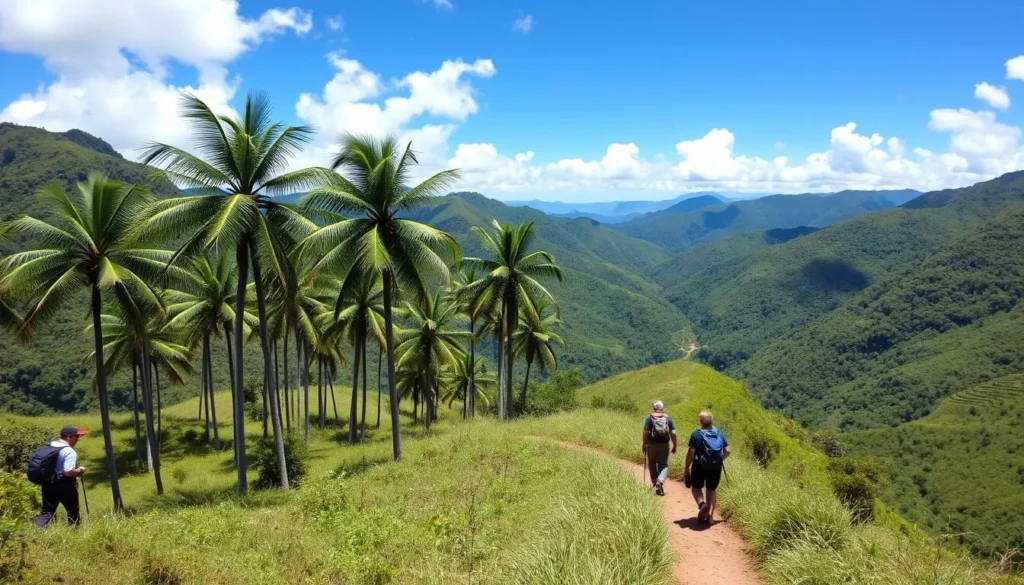
The Cocora Valley offers a variety of activities centered around its natural beauty. Here are the top experiences you shouldn’t miss during your visit:
1. Hike the Cocora Valley Loop Trail
The signature experience in the valley is hiking the full loop trail, which showcases the region’s diverse ecosystems:
- Distance: Approximately 12 km (7.5 miles)
- Duration: 5-6 hours at a moderate pace
- Difficulty: Moderate, with some steep and potentially muddy sections
- Highlights: Cloud forest, river crossings via suspension bridges, hummingbird sanctuary, and the iconic wax palm forest
Most hikers take the trail counter-clockwise, starting with the forest section and ending with the spectacular palm-dotted landscapes. This approach saves the most iconic views for last and tackles the steepest sections early in the hike.
Hiking Tip: Bring plenty of water, snacks, and lunch as there are limited places to purchase food along the trail. The only food service is at the Acaime hummingbird sanctuary, which offers hot drinks and simple snacks.
2. Visit the Acaime Hummingbird Sanctuary

Located about halfway through the loop trail, this small nature reserve is a haven for hummingbird enthusiasts:
- Observe 5-8 different species of hummingbirds at close range
- Entrance fee (6,000 COP / $1.50 USD) includes a traditional hot chocolate with cheese
- A perfect resting point during the hike with basic restroom facilities
- Best visited between 10 AM and 2 PM when hummingbird activity is highest
3. Horseback Riding Through the Valley
Experience the valley from a different perspective on horseback:
- Guided rides available from the valley entrance
- Options ranging from 1-hour rides through the palm forest to 3-4 hour excursions
- Prices start at approximately 40,000 COP ($10 USD) for a basic tour
- No prior riding experience necessary
Explore Cocora Valley on horseback
Book a guided horseback riding tour for a unique perspective of the valley’s stunning landscapes.
4. Photography in the Wax Palm Forest
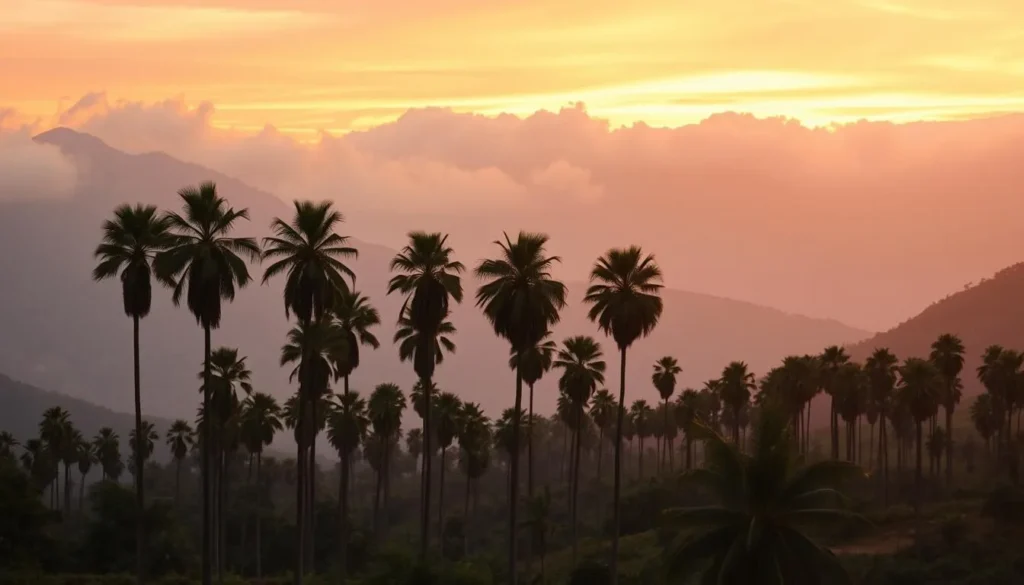
The valley’s surreal landscape makes it one of Colombia’s most photographed locations:
- Best Times: Early morning (7-9 AM) for soft light and fewer crowds, or late afternoon (4-5 PM) for golden hour
- Best Spots: The main viewpoint in the palm forest, the hills above the valley for panoramic views, and along the river for reflection shots
- Weather: Partly cloudy days often create the most dramatic lighting conditions
5. Visit Santa Rita Waterfall
Located near the small town of Boquia, just outside Salento, this beautiful waterfall makes for a great side trip:
- A 2-3 hour round-trip hike from the trailhead
- Entrance fee of approximately 7,000 COP ($1.75 USD) as it’s on private property
- Natural swimming pools perfect for cooling off on warm days
- Less crowded than the main Cocora Valley trails
Cultural Experiences & Coffee Tours

While the natural beauty of Cocora Valley is the main attraction, the surrounding region offers rich cultural experiences, particularly related to Colombia’s coffee heritage.
Coffee Farm Tours
The Cocora Valley is located in Colombia’s Coffee Triangle (Eje Cafetero), a UNESCO World Heritage site renowned for producing some of the world’s finest coffee. Visiting a coffee farm (finca) provides insight into the cultivation, processing, and cultural significance of coffee in Colombia:
- Finca El Ocaso: Offers comprehensive tours including bean-to-cup experiences and premium tasting sessions
- Finca Don Elias: A family-run organic farm with intimate tours often led by Don Elias himself
- Coffee Luger: Known for educational tours with knowledgeable guides and small group sizes
- Finca Las Acacias: Beautiful setting with views of the surrounding mountains
Most coffee tours last 2-3 hours and include a walk through the plantation, explanation of the growing and processing methods, and a tasting session. Prices typically range from 25,000-60,000 COP ($6-15 USD) depending on the farm and tour type.
Discover Colombia’s coffee culture
Book a coffee farm tour to learn about the bean-to-cup process and taste some of the world’s finest coffee.
Exploring Salento
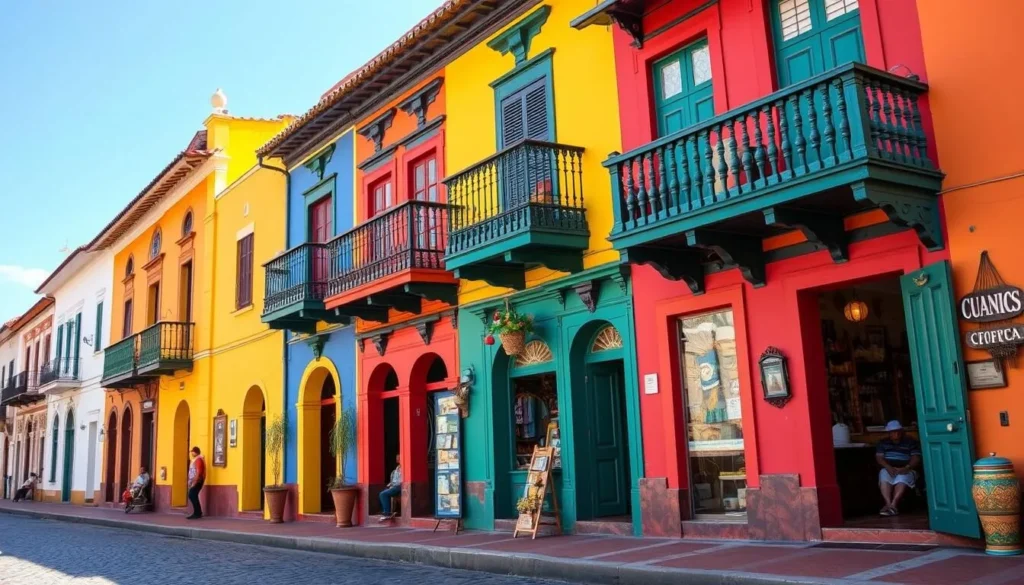
The charming town of Salento offers several cultural experiences:
- Calle Real: The main street lined with colorful colonial buildings, artisan shops, and cafés
- Plaza de Bolívar: The central square where locals gather and Willy jeeps depart for Cocora Valley
- Mirador Alto de la Cruz: A viewpoint reached by climbing 250 steps at the end of Calle Real, offering panoramic views of the town and surrounding valley
- Handicraft Shopping: Salento is known for its artisanal products, including woven bags, ponchos, leather goods, and handmade jewelry
Playing Tejo
For a uniquely Colombian cultural experience, try your hand at tejo, the national sport that involves throwing metal discs at targets packed with gunpowder:
- Los Amigos in Salento is popular with travelers wanting to learn the game
- The game is typically played while enjoying beer or the local aguardiente (anise-flavored spirit)
- Cost is minimal (around 5,000 COP / $1.25 USD) or free with drink purchases
- Staff will gladly explain the rules to beginners
Day Trip to Filandia
Just 30 minutes from Salento, the less touristy town of Filandia offers another perspective on the region’s culture:
- More authentic feel with fewer tourists than Salento
- Beautiful colonial architecture and colorful streets
- Mirador de Colina Iluminada viewpoint with spectacular valley views
- Helena Adentro restaurant, considered one of the best dining experiences in the coffee region
Willys jeeps run regularly between Salento and Filandia for approximately 8,000 COP ($2 USD) each way.
Outdoor Adventures Beyond Cocora Valley
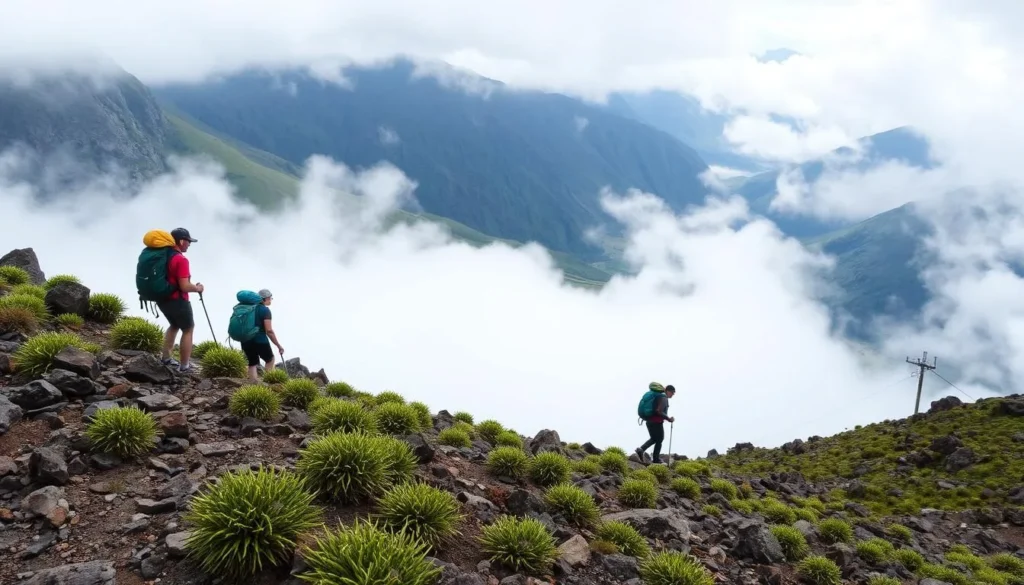
While the Cocora Valley is the region’s crown jewel, the surrounding areas offer additional outdoor adventures for nature enthusiasts.
Los Nevados National Natural Park
The Cocora Valley is actually part of the larger Los Nevados National Natural Park, which encompasses 58,300 hectares of diverse ecosystems:
- Multi-day Treks: For serious hikers, extended treks into the park offer opportunities to summit volcanoes and explore remote landscapes
- Páramo Ecosystem: Experience the unique high-altitude ecosystem with its distinctive frailejones plants
- Wildlife Viewing: The park is home to Andean condors, spectacled bears, mountain tapirs, and numerous bird species
Access to the more remote areas of the park typically requires a guide and permits. Several tour operators in Salento can arrange these expeditions.
Birdwatching
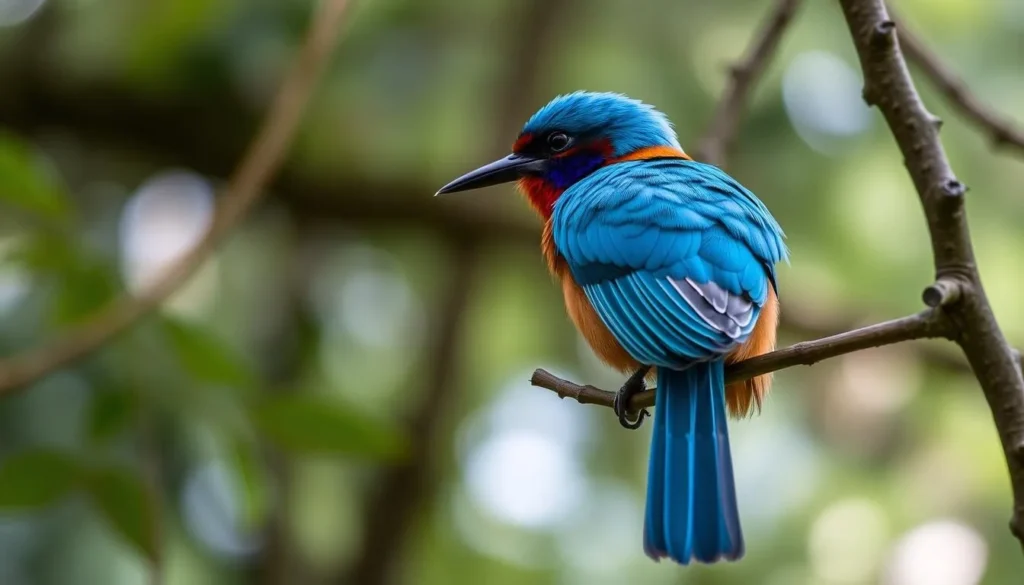
The region surrounding Cocora Valley is a paradise for birdwatchers, with over 400 species recorded:
- Early morning guided birdwatching tours offer the best chance to spot rare species
- The cloud forests are home to colorful tanagers, toucans, and the iconic Andean Motmot
- The Acaime sanctuary specializes in hummingbirds, with 5-8 species regularly visiting the feeders
- Lucky visitors might spot the majestic Andean Condor soaring above the valley
Discover Colombia’s incredible biodiversity
Book a specialized birdwatching tour with expert guides who know where to find the region’s most spectacular species.
Mountain Biking
The rolling hills and varied terrain around Cocora Valley make for excellent mountain biking:
- Guided tours can be arranged in Salento for riders of all skill levels
- Routes typically include coffee farms, rural villages, and scenic viewpoints
- Full-day tours include bike rental, helmet, guide, and often lunch
- Prices start at around 120,000 COP ($30 USD) for a half-day tour
Safety, Etiquette & Local Customs
The Cocora Valley and surrounding areas are generally safe for travelers, but it’s always good to be informed about local customs and safety considerations.
Safety Tips
- Trail Safety: Stick to marked trails in Cocora Valley. Some sections can be slippery, especially after rain, so appropriate footwear is essential.
- Weather Preparedness: Mountain weather can change rapidly. Bring layers, rain protection, and sun protection regardless of the forecast.
- Altitude Considerations: At 2,400 meters (7,874 feet), some visitors may experience mild altitude effects. Stay hydrated and pace yourself, especially when first arriving.
- Valuables: While crime is uncommon in the valley, it’s always wise to leave unnecessary valuables at your accommodation and keep cameras and phones secure.
- Solo Hiking: The main loop trail is generally safe for solo hikers as it’s well-trafficked. For more remote trails, consider hiring a guide or joining a group.
Local Etiquette
- Environmental Respect: The wax palms are protected by law. Never damage or carve into the trees, and stay on designated paths to minimize erosion.
- Photography: Always ask before photographing local people, especially indigenous individuals.
- Tipping: For guides, 10-15% is appreciated for good service. In restaurants, a 10% service charge is often included in the bill (labeled “propina” or “servicio”).
- Bargaining: Light bargaining is acceptable in markets and with street vendors, but not in established shops or restaurants.
- Greetings: Colombians are friendly and appreciate basic courtesy. A simple “Buenos días” (good morning) or “Buenas tardes” (good afternoon) goes a long way.
Cultural Insights
- Coffee Culture: Coffee is more than a drink in this region—it’s a way of life. Taking time to learn about the process shows respect for local heritage.
- Pace of Life: Things move more slowly in rural Colombia. Embrace the relaxed pace rather than expecting big-city efficiency.
- Colombian Time: Punctuality is somewhat flexible. Tours might start 15-30 minutes later than scheduled, which is considered normal.
- Language: While some tourism workers speak English, learning basic Spanish phrases will enhance your experience and is appreciated by locals.
Cultural Tip: When offered coffee or food in a local home or farm, it’s considered polite to accept even if you only take a small amount. Refusing outright can be seen as impolite in Colombian culture.
Practical Travel Tips for Cocora Valley

These practical tips will help you make the most of your visit to the Cocora Valley and avoid common pitfalls.
What to Pack
- Hiking Boots: Waterproof hiking boots are essential, as trails can be muddy even during the “dry” season.
- Rain Jacket/Poncho: Weather changes quickly in the mountains, so rain protection is a must year-round.
- Layers: Temperatures can range from cool mornings (around 10°C/50°F) to warm afternoons (25°C/77°F).
- Sun Protection: The equatorial sun is intense at high altitudes. Bring sunscreen, a hat, and sunglasses.
- Insect Repellent: Particularly important in the cloud forest sections of the hike.
- Water and Snacks: Bring at least 1.5 liters of water per person and energy-rich snacks for the hike.
- Cash: ATMs are limited to Salento, and most places in the valley only accept cash.
Money Matters
- Currency: Colombian Peso (COP). As of 2024, approximately 4,000 COP = 1 USD.
- ATMs: Available in Salento but can be unreliable. Withdraw cash before arriving if possible.
- Cards: Major hotels and some restaurants in Salento accept credit cards, but most smaller establishments and all services in Cocora Valley are cash-only.
- Costs: Budget approximately 30,000-50,000 COP ($7.50-12.50 USD) per person for a day in Cocora Valley, including transportation, entrance fees, and a simple meal.
Communication
- Mobile Coverage: Basic cell service is available in most of Cocora Valley, but can be spotty in some areas of the trail.
- Wi-Fi: Available in most accommodations in Salento, but not in the valley itself.
- Language: Spanish is the primary language. While tourism workers may speak some English, having a translation app or basic Spanish phrases is helpful.
Health Considerations
- Altitude: At 2,400 meters (7,874 feet), some visitors may experience mild altitude symptoms. Stay hydrated and avoid strenuous activity on your first day.
- Water: Tap water in Salento is generally safe, but bottled water is recommended for sensitive stomachs.
- Medical Facilities: Basic medical services are available in Salento, with more comprehensive care in Armenia (45 minutes away).
- Travel Insurance: Comprehensive travel insurance covering outdoor activities and emergency evacuation is strongly recommended.
Pro Tip: Download offline maps of the Cocora Valley area before your visit. Apps like Maps.me or Google Maps (offline) can be invaluable for navigation, especially on the hiking trails where signage can be minimal.
Ready to Experience Cocora Valley?
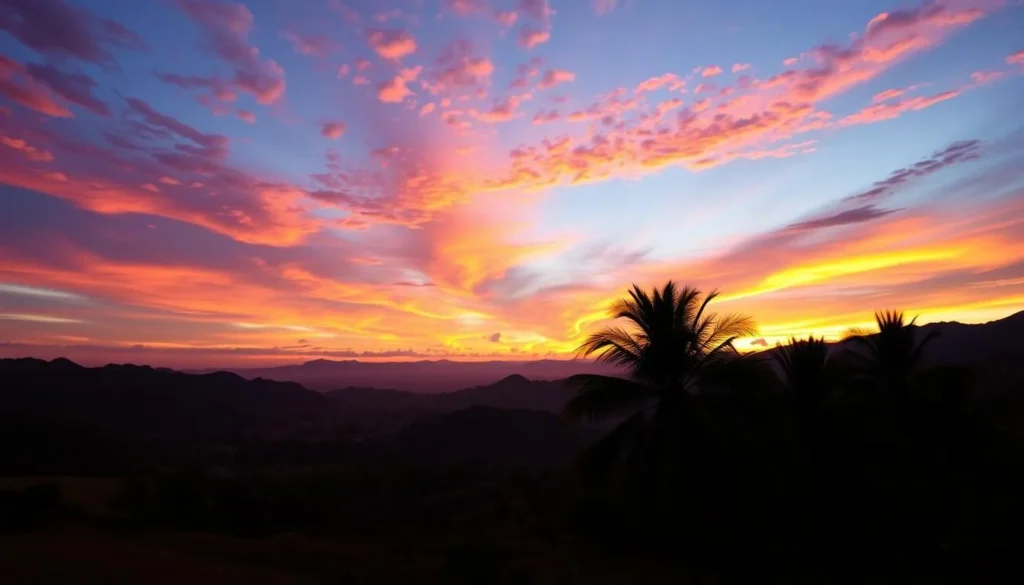
The Cocora Valley offers one of Colombia’s most magical landscapes—a place where the world’s tallest palm trees create a surreal forest against a backdrop of mist-shrouded mountains. Walking among these giants, some over 60 meters (197 feet) tall and living for up to 100 years, is an experience that stays with travelers long after they’ve left.
Whether you come for the hiking, the photography, the coffee culture, or simply to immerse yourself in the natural beauty, Cocora Valley delivers an unforgettable adventure. The combination of breathtaking scenery, rich biodiversity, and the warm hospitality of the coffee region makes this a must-visit destination in Colombia.
From the moment you climb aboard a colorful Willy jeep in Salento’s main square to your first glimpse of those towering wax palms, you’ll understand why this valley has captured the imagination of travelers from around the world. It’s not just the iconic palms that make this place special—it’s the entire experience of being in a landscape that seems almost otherworldly in its beauty.
Start planning your Cocora Valley adventure today
Book your flights, accommodations, and tours to experience one of Colombia’s most spectacular natural wonders.
Ready to walk among giants? The towering wax palms of Cocora Valley await your visit!
The above is subject to change.
Check back often to TRAVEL.COM for the latest travel tips and deals.
